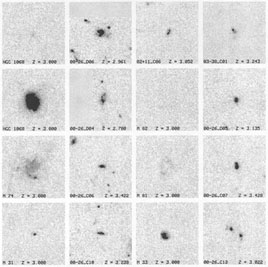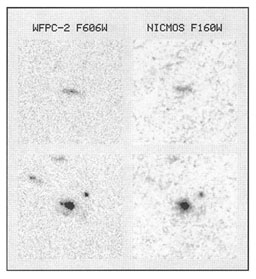


At the time of this writing, only the morphology of the far-UV light of Lyman-break galaxies has been studied with HST in some detail in both the ground-based and HDF sample (Giavalisco et al. 1996a; Steidel et al. 1996b; Lowenthal et al. 1997). These studies have revealed a dispersion of properties. Galaxies from the ground-based sample are characterized by rather compact and relatively regular morphologies, while those from the HDF, which are on average considerably fainter, include a larger number of more diffuse, irregular and apparently "disturbed" cases.
Figure 6 shows the HST + WFPC2 image of
0000-263-D6 at z = 2.961, an example
of Lyman-break galaxy with compact morphology from the ground-based sample
(Giavalisco et al. 1998 in prep.). The image has been taken through the
F702W passband
and samples the rest-frame spectrum at
 ~ 1700 Å. We have
displayed it with two
different levels of contrast to show the compact "core" of the galaxy
and the surrounding
diffuse nebulosity or "halo" that extends up to a few arcsec. This is
representative of the
morphology of the compact Lyman-break galaxies. The cores segregate ~
90% of the
total light and tend to have regular morphologies, characterized by a
relatively steep light
profile that is often well approximated by a r1/4 law,
but exponential profiles have also been observed
(Giavalisco et
al. 1996b).
Surrounding the core there is a diffuse "halo"
with an irregular light distribution, sometimes harboring faint, compact
sub-structure.
The half-light radii of the cores are typically ~ 0.2-0.3 arcsec or ~
2.2-3.4 (~ 1.5-2.2)
h-150 kpc at z = 3, while the
observed isophotal diameters (lower limits to the intrinsic
sizes due to the extreme (1 + z)4 surface brightness
dimming), are typically 1.5-2 arcsec
or ~ 17-22 (~ 11-15) h-150 kpc.
~ 1700 Å. We have
displayed it with two
different levels of contrast to show the compact "core" of the galaxy
and the surrounding
diffuse nebulosity or "halo" that extends up to a few arcsec. This is
representative of the
morphology of the compact Lyman-break galaxies. The cores segregate ~
90% of the
total light and tend to have regular morphologies, characterized by a
relatively steep light
profile that is often well approximated by a r1/4 law,
but exponential profiles have also been observed
(Giavalisco et
al. 1996b).
Surrounding the core there is a diffuse "halo"
with an irregular light distribution, sometimes harboring faint, compact
sub-structure.
The half-light radii of the cores are typically ~ 0.2-0.3 arcsec or ~
2.2-3.4 (~ 1.5-2.2)
h-150 kpc at z = 3, while the
observed isophotal diameters (lower limits to the intrinsic
sizes due to the extreme (1 + z)4 surface brightness
dimming), are typically 1.5-2 arcsec
or ~ 17-22 (~ 11-15) h-150 kpc.
The Lyman-break galaxies from the HDF have UV morphologies that tend to be less
regular and more fragmented than their ground-based counterparts. In
part, this can be
due to the increased depth of the HDF over the WFPC-2 images of the
ground-based
sample. This has certainly made fainter features being detected with a
relatively high
S/N ratio and these can now contribute to the overall appearance of the
structures.
However, we must remember that most of the HDF galaxies belong to a
fainter portion
of the luminosity function and have, on average, a smaller
redshift. Only a few of them
have luminosity that can be directly compared with the ground-based ones
(Steidel et al. 1996b).
More importantly, as mentioned above and discussed by Dickinson,
the HDF
data seem to suggest that some amount of evolution in the number density
of Lyman-break galaxies has taken place in the redshift range 2
 z
z
 3. Because we do not know
the redshift distribution of the fainter HDF U-band dropouts -
this could plausibly be dominated by galaxies at z
3. Because we do not know
the redshift distribution of the fainter HDF U-band dropouts -
this could plausibly be dominated by galaxies at z
 2 - it is not entirely
clear that the HDF and ground-based
Lyman-break galaxies belong to the same "population". It would be quite
plausible that
a insurgent population at z ~ 2 be characterized by a more
irregular UV morphologies than the one at z ~ 3.
2 - it is not entirely
clear that the HDF and ground-based
Lyman-break galaxies belong to the same "population". It would be quite
plausible that
a insurgent population at z ~ 2 be characterized by a more
irregular UV morphologies than the one at z ~ 3.
Overall, the morphology of the UV light of the Lyman-break galaxies is suggestive of relaxed structures. In particular, the fact that these morphologies are relatively regular for galaxies with high absolute luminosity (large star-formation rates) and become more irregular and fragmented at fainter absolute luminosities reinforces the idea that star formation takes places in virialized dark halos with an efficiency that is directly related to their mass and/or the degree of relaxation. The presence of relaxed structures at these redshift is certainly not surprising and it is actually consistent with the expectations of most theories of galaxies formation, which predict that the most actively star-forming regions are located in correspondence of the bottom of the potential well of virialized dark halos (e.g., Baugh et al. 1998). What it is interesting here is that the observed sizes are relatively large. As discussed by Giavalisco, Steidel & Macchetto 1996) the half-light radii and isophotal diameters of LBGs are similar to the effective radii re and sizes of present-day elliptical galaxies of intermediate luminosities and bulges of spirals. At z ~ 3 these are about one order of magnitudes larger than the expectations from the semi-analytical models based on the CDM theory (e.g., Baugh et al. 1998). Furthermore, the theory predicts systems dominated by a disc morphology, while the observations show the predominance of spherically symmetric structures, with very few cases of highly elongated systems (an example of these rather rare cases is 0000-263-C10 whose optical and near-IR images are shown in Figure 8, top row).
In this respect it is interesting to compare the UV morphologies of high- and low-redshift galaxies (Giavalisco et al. 1996). Figure 7 shows local galaxies, observed with UIT and the SW camera at ~ 1550 Å, as HST would have observed them in the F606W passband if they were placed at redshift z = 3 (first and third column of the figure except the top panel of 3rd column. See labels), compared against HST LBGs. The images are all photometrically consistent, however we had to boost the surface brightness of the local galaxies by a factor of 100 to detect them with the same exposure time of the HST observations (5 hours). This exercise shows that 1) the sizes of the inner regions (i.e., where the oldest stellar population are generally thought to be located) are similar to those of the LBGs; 2) the local galaxies have significantly less star formation per unit volume (proportional to the UV surface brightness) than their distant counterparts and, as the images show, this is distributed in the disc, while the bulges or central regions contribute very little.

|
Figure 7. WFPC2+F606W images of LLGs and local galaxies as HST would observe them if placed at z = 3. We had to boost their surface brightness 100x to detect them in 5 hr except NGC 1068, shown before and after the boost. Panels are 7 arcsec in size and q0 = 0.1. |
In local galaxies star formation is generally localized in small regions that involve a small fraction of the stellar mass. Thus, the UV morphology can be substantially different form the optical one, and the effects of the morphological k-correction can be relatively large, shifting the position of the galaxy in the Hubble sequence towards later types at bluer wavelengths. The LBGs, on the other hand, are systems that are assembling the bulk of their stars, and star formation is propagated to a much larger fraction of their structure. Therefore, in this case it is plausible that their UV morphology more closely traces that of the final structure. This seems directly supported by the similarity between the rest-frame UV and optical morphologies of the Lyman-break galaxies revealed by recent NICMOS images (Giavalisco et al. 1998, in prep.), as shown in Figure 8.

|
Figure 8. Comparison between the rest-frame
UV and optical morphologies of 2 Lyman-break
galaxies, 0000-263-C10 at z = 3.238 (top) and 0000-263-D6 at
z = 2.961 (bottom). The UV
images have been obtained with WFPC-2/PC and the F606W passband
(rest-frame |